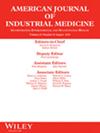Applying the NIOSH Worker Well-Being Framework to Migrant and Seasonal Farmworkers: Insights From the Literature
Abstract
Background
There is a growing appreciation of the importance of health and well-being and of the complex set of factors, within and outside the workplace, that interact to affect the well-being of workers. Migrant and seasonal farmworkers experience particular challenges, and measurement of factors that influence their health and well-being is important to the ethical sustainability of this critical workforce.
Methods
To examine the applicability of the NIOSH Worker Well-Being Framework to the health and well-being of farmworkers, we conducted a literature review to (1) explore the ways in which the domains, subdomains, and constructs of the framework are described in studies of farmworkers, and (2) identify additional constructs that are not described or not in alignment with the framework.
Results
Four reviewers used a thematic analysis approach to identify and summarize key areas of alignment and non-alignment of 163 included articles. We found alignment with the five framework domains and their sub-domains, though several are understudied or narrowly operationalized in studies of farmworkers. The vast majority of studies addressed contributors to poor health. We found five additional cross-cutting or unaligned themes (legal status, discrimination, exploitation, fear of retaliation, fear of deportation).
Conclusions
External and work-related social factors are important to the well-being of the farmworker workforce. Contextual determinants of employment precarity, hazardous occupational and nonoccupational exposures, and social safety nets should be considered in comprehensive assessments of worker well-being. Other precarious and immigrant workforces may also require expansion of the NIOSH Worker Well-Being Framework.


 求助内容:
求助内容: 应助结果提醒方式:
应助结果提醒方式:


